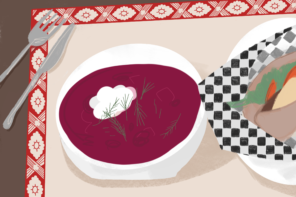Gastronomy is filled with temporary fads that overtake restaurants of various kinds around the world. Whether it be deconstructed food, which took influence from molecular gastronomy and advanced culinary techniques, or the recent emphasis on farm to table, which looks towards organic, local, and sustainable ingredients. There is always a new craze that chefs look to emulate, so that begs the question, what is the next trend in the world of gastronomy?
First, I think it’s important to note what trends I don’t think will be continuing in popularity. The one that comes to mind immediately is technology-enhanced food, with an ever growing world of A.I models, technology surrounds almost all aspects of our daily lives. Despite the ways I think innovation can optimize supply chain issues, when it comes to food being served in restaurants, I have a hard time believing many would prefer having their red meat 3D printed. I do believe these recent innovations will have it’s moment at some point but I think it will be relatively short lived, unless it comes to a fraction of the price of “real” ingredients.
Moving on, here are a few basic ingredients that I think will take off in years to come due to their versatile, complex, and rich flavors. First, I think Yuca as a potato substitute will have a big moment in the future of the food space. Sweet potatoes had their time as a potato substitute, often used in french fry form, but I think Yuca will rise in prominence with the ever-growing Latin influence of the world of gastronomy. Another ingredient that I think will continue to rise in popularity is Ube, a vibrantly colored purple yam native to the Philippines, known for its sweet, and unique flavor and often used in desserts like ice cream, cakes, and various other sweet treats. Next, we shift our focus slightly more north in Asia and look at gochujang or Korean red chili paste. It is a savory, sweet, and spicy fermented condiment often used in traditional recipes like tteok-bokki, dak-bokkeum-tang, or pork bulgogi. I think as Korean food continues to become increasingly mainstream, gochujang will be at the forefront, due to its multi-purpose properties and mildly spicy flavor. The next item that I think will continue to grow is, Chimichurri, an Argentine condiment often used as a topping for red meat or chorizo, it consists of parsley, olive oil, oregano, lemon juice, and vinegar. Continuing on the theme of Argentina, I have noticed increased popularity of Yerba Mate, as a new caffeine source, through canned variants such as Mate Libre, Mateina, or Guayaki. Mate, if you are unfamiliar is a herbal tea that is served in a gourd like vessel. It has proven benefits for focus, digestion, and overall health. I think with the increase of availability through canned versions, Mate’s popularity as a coffee substitute will only continue to grow.
Next, I wanted to highlight two cuisines that I think will have increased popularity in the world of gastronomy in upcoming years. Chinese, Japanese, and Thai have had long standing popularity in North America, however, I think the next Asian giant to take over the food space, is Filipino cuisine. With staples like Adobo, Kare-Kare, and Bibingka, Filipino cuisine has the variety, heartiness, and spice to become a mainstream sensation. I think to Chicago’s Kasama, the first Filipino restaurant to be awarded a Michelin Star, featuring staples like adobo mussels and wild mushrooms, as well as delightful pastries such as the ube and huckleberry basque cake. They are setting the precedent for how you can elevate classic Filipino dishes and make them both gourmet and simple. The next cuisine I think will take off in the future is a reworking of classic Caribbean recipes such as plantains, jerk chicken, oxtail, and various seafood dishes. In Montreal, Kwizinn is pioneering this trend through their “blending of traditional Caribbean spices with contemporary culinary techniques to create unique fusion dishes such as our octopus carpaccio, lobster poutine, plantain burger, and bao fall of da bone.” My last prediction for popular cuisines in the future of gastronomy, is West African and French fusion, taking ingredients from both cultures and harnessing their intertwined cultural history. For example, Baguette Brochette is a fast-casual Montreal staple that, “expertly combines the essence of African street food with classic French sandwicherie.” I think increasing representation for West African or regional subsets of Africa will break out in the world of gastronomy in the coming years.
Can’t forget about the drinks, here are some beverage trends that I think will break out in the coming years. First, with the resurgence of the hit TV show, Sex And The City, with it’s recent availability on Netflix, the go to classic of the characters, the famed Cosmopolitan or also known as the Cosmo. For those who are unfamiliar, a Cosmo is a cocktail made with vodka, Cointreau, cranberry juice, and freshly squeezed or sweetened lime juice. Easily recognizable for it’s bright color, I think the Cosmo will make a comeback and overtake the Espresso Martini or Negroni for the drink of years to come. Switching our focus to a drink for earlier in the day, I think the Cortado will be the next trend in the coffee world, with Starbucks recently making headlines for adding it to their menu. A Cortado is a coffee drink originating in Spain, made of equal parts espresso and warm milk. I think influencers will soon fixate on this new trend of coffee, and it will give the latte a run for it’s money.
Lastly, I wanted to focus on a few industry wide trends I think will continue to grow in popularity. First, is the blend between restaurant, bar, and club, what I mean by this is having food being served at a bar exclusively, or having a restaurant turn into a night club after hours. One place that comes to mind is Montreal’s Tiradito, an 18+ restaurant that has all seating in a bar style as they serve and cook Peruvian tapas in front of you. Finally, I think city-wide organized restaurant weeks will continue to grow in popularity as it gives diners the ability to dine at certain restaurants for a lowered price and gives the restaurants increased exposure. I have experienced Chicago’s Restaurant Week first hand and thought the idea was ingenious.
In summary, gastronomy is an ever-changing industry with new trends constantly emerging from all over the globe. In this article, I highlighted ingredients like Yuca, Ube, Gochujang, and Chimichurri. Cuisines like Filipino, Caribbean, and African-French fusion. Drinks like the Cosmo or Cortado. And lastly trends like a blend between restaurant, bar, and club and city-wide restaurant weeks will continue to grow in popularity.








